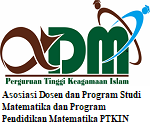Analysis Infiltration Waters in Various Forms of Irrigation Channels by Using Dual Reciprocity Boundary Element Method
DOI:
https://doi.org/10.15642/mantik.2020.6.1.52-65Keywords:
Infiltration; Periodic channels; DRBEMAbstract
This research discusses the infiltration of furrow irrigation invarious forms of irrigation channels in homogeneous soils. The governing equation of the problems is a Richard’s Equation. This equation is transformed using a set of transformation including Kirchhoff and dimensionless variables into Helmholtz modified equations. Furthermore with Dual Reciprocity Boundary Element Method (DRBEM), numerical solution of modified Helmholtz equation obtained. The proposed method is tested on problem involved infiltration from periodic flat channels, non-flat channels without impermeable and non-flat channels with impermeable. The greatest value of suction potential and water content is located below the channel surface. The most water consecutively is a non-flat channel without impermeable, non-flat channel with impermeable and flat channel on Lakish Clay soils.
Downloads
References
UN World Water Assessment Programme, The United Nations World Water Development Report 2015. UNESCO, 2015.
M. G. Bos, R.A.L. Kselik, R. Allen, and D. Molden, “Water Requirements for Irrigation and the Environment”, 2009, doi: 10.1007/978-1-4020-8948-0.
M. Manaqib, I. Fauziah, and M. Mujiyanti, "Mathematical Model for MERS-COV Disease Transmission with Medical Mask Usage and Vaccination", Inprime: Indonesian Journal of Pure and Applied Mathematics, vol. 1, no. 2, pp. 97-109, 2019. doi: 10.15408/inprime.v1i2.13553
I. Solekhudin and K.C. Ang, "A dual-reciprocity boundary element method for steady infiltration problems", ANZIAM Journal, vol. 54, pp. 171-180, 2013. doi: 10.21914/anziamj.v54i0.5699
C. Pozrikidis, A Practical Guide to Boundary Element Method with The Software Library BEMLIB. Florida: Chapman and Hall/CRR, 2002.
J. T. Katsikadelis, Boundary Element: Theory and Application. Oxford: Elsevier, 2002.
M. I. Azis, D. L. Clements, and M. Lobo, "A Boundary Elements Method for Steady Infiltration from Periodic Channels", ANZIAM Journal, vol. 44, pp. C61-C78, 2003. doi: https://doi.org/10.21914/anziamj.v44i0.672.
M. Manaqib and I. Solekhudin, "Dual Reciprocity Boundary Element Method untuk Menyelesaikan Masalah Infiltrasi Air pada Saluran Irigasi Alur," in Seminar Matematika dan Pendidikan Matematika UNY, Yogyakarta, 2017.
E. Bresler, "Analysis of Trickle Irrigation with Application to Design Problems", Irrigation Science, vol. 1, pp. 3-17, 1978.
A. W. Warrick, Soil Physics Companion. Washington D.C.: CRC Press, 2002.
M. Manaqib., “Pemodelan Matematika Infiltrasi Air pada Saluran Irigasi Alur”, J. Mat. Mantik, vol. 3, no. 1, pp. 23-29, Oct. 2017.
V. Batu, “Steady Infiltration from Single and Periodic Strip Sources”, Soil Science Society of America Journal, Vol. 42, pp. 544-549, 1978. doi:10.2136/sssaj1978.03615995004200040002x
M. Lobo, D. L. Clements, and N. Widana, "Infiltration from Irrigation Channels in a Soil with Impermeable Inclusions," ANZIAM Journal, vol. 46, pp. C1055-C1068, 2005.
D. L. Clements, M. Lobo, and N. Widana, "A Hypersingular Boundary Integral Equation for a Class of a Problems Concerning Infiltration from Periodic Channels", Electronic Journal of Boundary Element, vol. 5, no. 1, pp. 1-16, 2007. doi: https://doi.org/10.14713/ejbe.v5i1.779.
I. Solekhudin and K.C. Ang, "Suction Potential and Water Absorption from Periodic Channels in Different Types of Homogeneous Soils," Electronic Jurnal of Boundary Element, vol. 10, no. 2, pp. 42-55, 2012.
Downloads
Published
How to Cite
Issue
Section
License
- Authors retain copyright and grant the journal right of first publication with the work simultaneously licensed under a Creative Commons License that allows others to share the work with an acknowledgment of the work's authorship and initial publication in this journal.
- Authors are able to enter into separate, additional contractual arrangements for the non-exclusive distribution of the journal's published version of the work (e.g., post it to an institutional repository or publish it in a book), with an acknowledgment of its initial publication in this journal.
- Authors are permitted and encouraged to post their work online (e.g., in institutional repositories or on their website) prior to and during the submission process, as it can lead to productive exchanges, as well as earlier and greater citation of published work







.png)




